In December of 2017, the Iranian-American cookbook author Najmieh Batmanglij tasted سوراغ (romanized: sooragh) for the first time in Evaz, a small inland town in the south of Iran. Halimeh Jonaybi, a local woman and talented cook, made the sooragh from scratch in her backyard under the shade of an old wild palm tree. Batmanglij remembers the salty, fishy taste of the sooragh, which had been pickled and preserved in a clay jar. Sooragh is a deep crimson sauce with a particular minerality that is native to the Hormozgan region, specifically to Hormuz, a 16-square-mile, teardrop-shaped island in the Persian gulf just five miles from the Iranian coast. The sauce’s main ingredient is گِلَک (romanized: gelak), or the edible red earth, a soil on Hormuz’s surface.
In her book, Cooking in Iran: Regional Recipes and Kitchen Secrets, Batmanglij adapts Jonaybi’s recipe for sooragh. First, she tells her reader to coat the interior of a medium-sized earthenware jar with a sprinkle of coarse sea salt. Then, remove the heads of freshly caught momegh (sardines). Use a sharp knife to cut the bellies from one end to another. Discard the guts. Rinse, drain, and pat dry. Rub the remaining flesh of the fish with salt and add back to the jar. Cover tightly and leave to bask in the hot sun for two weeks. Then, remove the fish and rub them thoroughly with the gelak, dying them deep red. Return the fish to the jar and delicately place peels of narenj (a sour orange) and leaves of lime in between each layer of fish. Leave the mixture in the sun again, this time for three weeks. The end result is sooragh: lava-red, sour and salty, the perfect condiment for bread, rice, or a dish of lentils and shrimp.
Sands ranging from golden-turmeric yellows to sea kelp greens to reds the color of saffron threads have given Hormuz the nickname, “the rainbow island.” But only one soil, gelak, is edible and a critical ingredient in the island’s local cuisine. Hormuz locals, all 6,000 of them, never eat gelak in its powdery form, but rather use it as a spice, most commonly to prepare sooragh.
Perhaps the most popular pairing for sooragh is a wafer thin crepe called tomshi (or nan-e tu moshi/tu moshti), which roughly translates to “fist pancakes.” Tomshi is not unique to Hormuz, but a popular street food served in the busy markets of cities along the Persian Gulf’s coastline that smell of tobacco and hot spices.
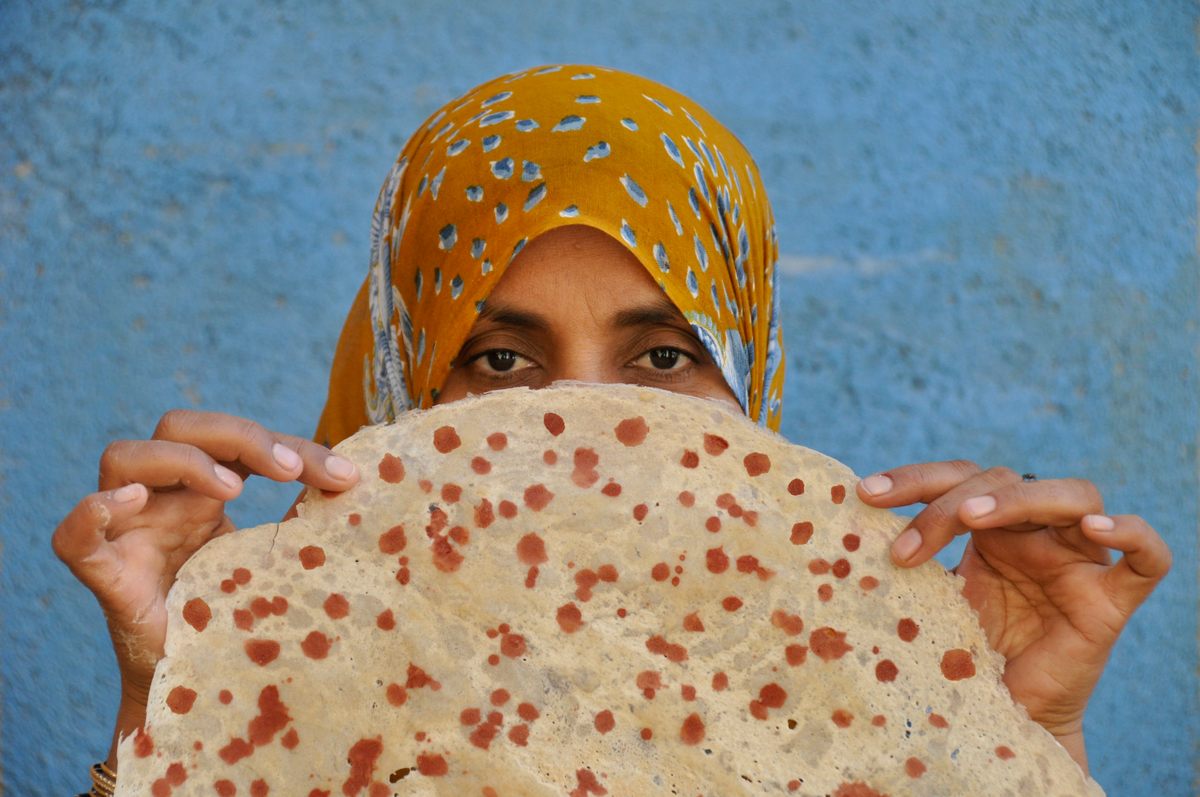
Artist and founder of his namesake museum in Hormuz, Ahmad Nadalian, notes that the majority of the cooks in Hormuz who make tomshi are women. They create fires in the narrow and winding alleys on the fringes of the neighborhoods, or at the base of the mountain where locals collect gelak right from the ground. Tomshi, Nadalian says, is cheap, moreso eaten as a snack rather than a full meal, and popular, specifically among the tourists who are eager to try the island’s edible soil.
Complementing her recipe for sooragh, Batmanglij includes a recipe for tomshi that she learned from Raviyeh Daryarnavardi, a calm and confident woman from nearby Qeshm. In Cooking in Iran, Batmanglij remembers Daryarnavardi’s process of making tomshi, beginning with a fistful of a smooth yogurt-like batter (made simply from flour, salt, and warm water and whisked for nearly 10 minutes). Daryarnavardi spreads the batter evenly over a scalding hot skillet, or saj, with her bare hands, a tradition that is dwindling with the rise of new tools and devices. The flatbread cooks quickly, nearly 30 seconds on each side.
Dr. Nader Mehravari, a Research Associate at the College of Agriculture and Environmental Sciences, University of California, Davis,* has studied flatbreads from the Hormozgan region, tomshi being one of them. He notes that when ordering tomshi, customers can opt for a variety of sauces, including sooragh and mayhaveh, a similar fish sauce. The key difference between the two sauces is their coloring. Mahyaveh is murky brown, whereas sooragh is “actually a somewhat pleasing dark red color,” Mehravari says. They taste similar, implying, according to Mehravari, that gelak is ultimately an aesthetic addition.
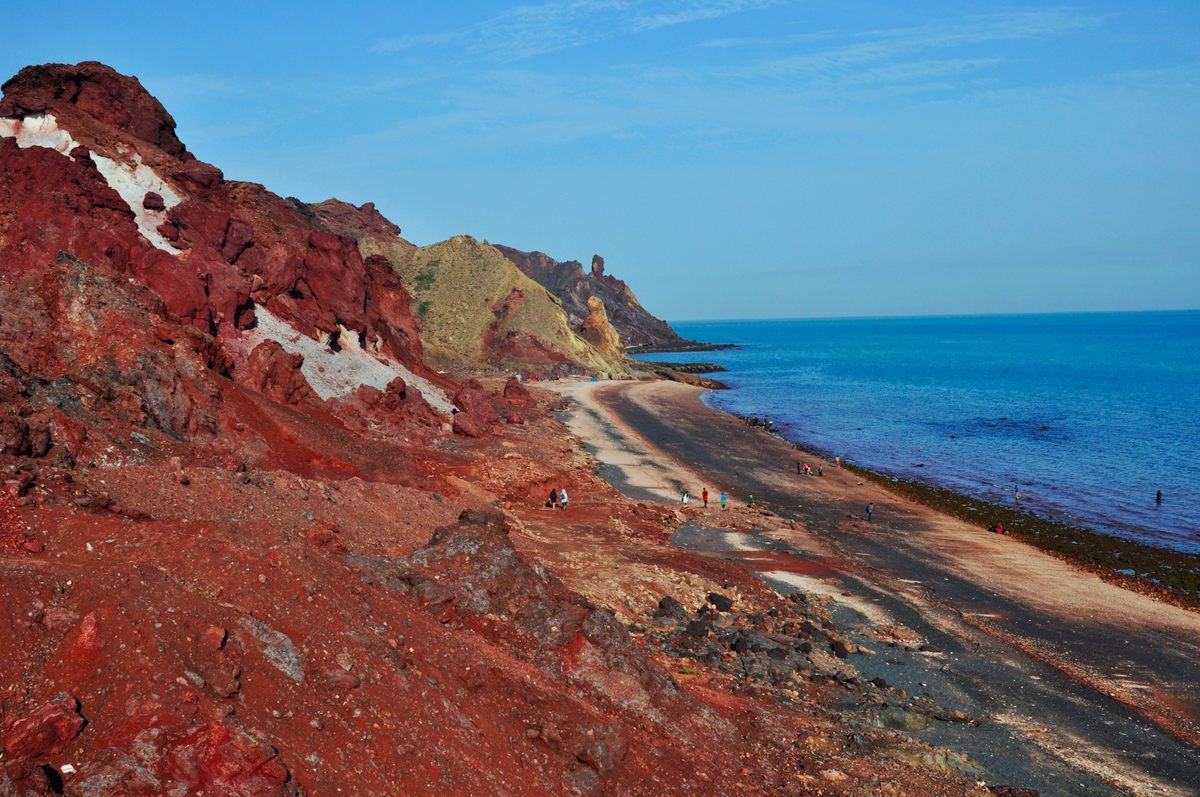
Hormuz locals do believe there are health benefits to gelak. Mahmoud Hormozi, director of the island’s Ahmad Nadalian Museum, writes, “gelak has nutritional value for the natives.” Najmieh Batmanglij confirms this by email, saying “locals believe eating small amounts of the sooragh every day gives the body strength.” This may be the traditional view, but Mehravari, whose research on gelak takes a more scientific approach, is skeptical of gelak’s proposed medicinal properties. While he has not seen health benefits proven scientifically, Mehravari confirms that gelak “contains several different iron chemicals. It is possible that for those who are iron-deficient, eating the sauce will help increase the required level of iron in the body.”
This iron density gives gelak its Mars-like hue. Hormuz is a geologic phenomenon known as a salt-gypsum dome, which, Mehravi says, occurs when numerous salt deposits beneath the ground rise to the surface when pressurized. The geographic features of the island make it arid, almost barren agriculturally. Seafood makes up a great deal of the local diet. Otherwise, most ingredients are imported from the Iranian mainland. Fresh water was scarce on the island until a few years ago when the government constructed a pipeline connecting to the mainland. It’s no surprise that locals turned to their native environment as a source of sustenance. Beyond gelak, though, the sands are not palatable.
“I know for a fact that some of the other soils in a typical salt dome actually taste pretty bad, chemically and sort of bitter,” Mehravari says, noting his research on the subject. “I’m not surprised that [they’re] not used for culinary purposes.”

No one knows the reason for the particular edibility of gelak, nor the origin of its culinary use. It should be noted that geophagy (eating small amounts of the earth) has also been documented in Nishapur, a city within the northern Khorasan province of Iran. In Hormoz, some attribute the invention of salty sooragh to the Portuguese colonizers who captured the island in the 16th century, according to Batmanglij. However, Mehravari found no mention of the red soil’s consumption in his research of the Portuguese conquest. It remains a mystery riddled with theories and assumptions.
Lately, though, gelak is being used less in local cuisine. “Now it’s more common for tourists who come and visit,” says Nadalian. This isn’t to say that locals don’t enjoy sooragh, Nadalian caveats, it’s just a way for tourists to both experience the local cuisine and eat the island’s most attractive feature: colored soil.
Tourism, mostly from the Iranian mainland, and increased immigration have influenced Hormuz in the last few years. “It has totally changed,” says Nadalian, who remembers the number of cars on the island growing from fewer than 10 in 2006, to hundreds, maybe thousands now. There are more cafes, hotels, and hostels than ever before. Tourism has spawned a growing economy, but locals fear their native culture might be lost. The native culture of Hormuz is one of complex rituals and ancient traditions, many of which involve gelak.
Museum director Mahmoud Hormozi says that, traditionally, locals painted a narrow, conical symbol in the middle of the forehead with gelak for Nowruz (the Persian New Year), in order to repulse the evil eye and grant good fortune. On the day of Ashura, a ceremony that marks the Battle of Karbala and thus resulted in the martyrdom of the grandson of the prophet of Muhammed, Husayn Ibn Ali, participating mourners wipe gelak messily on their clothes symbolizing blood and grief while demonstrating in the streets. Now, one might still see gelak rubbed onto trees, giving the appearance of a scorched and bleeding trunk: a preventive measure against pests believed to lengthen the tree’s life.
These traditions are fading fast, but “[w]ithout tourism, the island cannot carry on,” Nadalian says.

Gelak, mined for use in dyes and paints, was once Hormuz’s largest export. Nadalian notes that private exportation of the raw material kept wealth in the hands of a few. Gelak became endangered and further sustained mining would lead to environmental degradation. In the mid-aughts, the Iranian Department of Environment, with pressure from local protestors, restricted commercial mining. Now, only a hollowed-out mining factory remains, dyed deep paprika-red from years of abandon. Artists and cooks who wish to use gelak may now collect it at their convenience from the mountains in the “horn” of the island. Obtaining gelak is a rather simple process. Since the moratorium on commercial mining, locals may dig into the surface of the island and collect the red soil at their convenience. For his art installations, Nadalian collects soil directly from nature and then takes it to a local woman who smashes or grates it into a fine powder.
At once a symbol of blood, strength, health, and luck to the island’s living, and also a critical to the local economy, gelak is imbued with a complex variety of meanings in Hormuz. It is not surprising that Batmanglij remembers the locals believing gelak to be a gift from God. “There are more than one hundred different types of colored soil in Hormoz Island,” Hormozi writes. “The most important soil in Hormoz is the red soil.”
*Correction (1/20/22): This article previously stated that Nader Mehravari works at the Iranian Diaspora Studies Department at San Francisco State University. While Mehravari volunteers at the Iranian Diaspora Studies Department, his official title is Research Associate at the College of Agriculture and Environmental Sciences, University of California, Davis.
Gastro Obscura covers the world’s most wondrous food and drink.
Sign up for our regular newsletter.
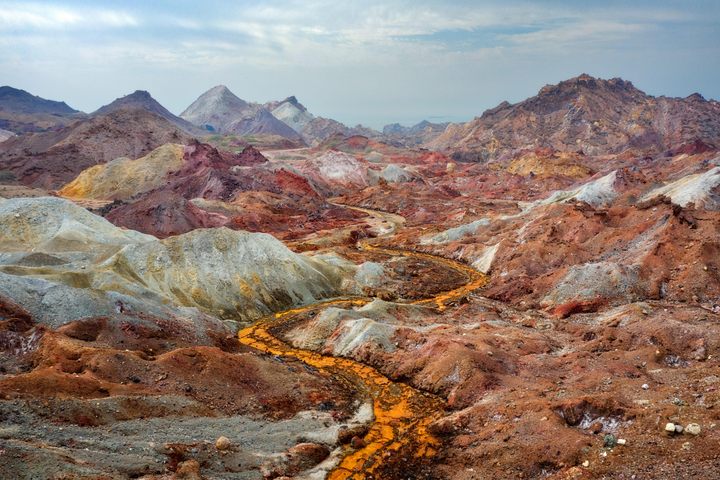



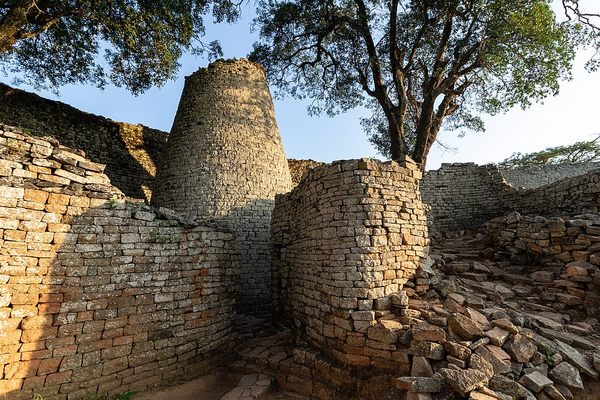
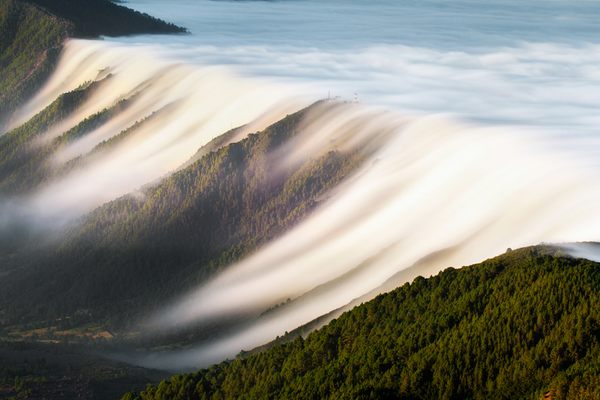
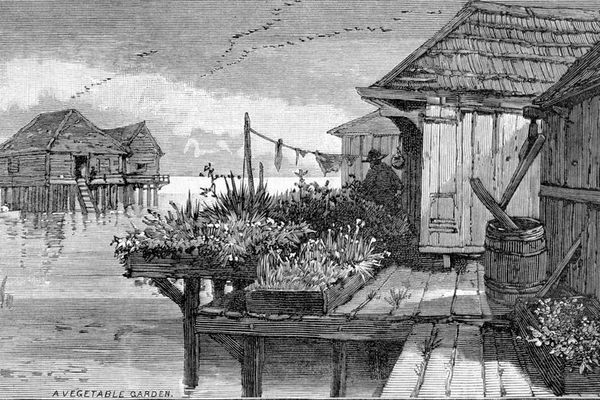
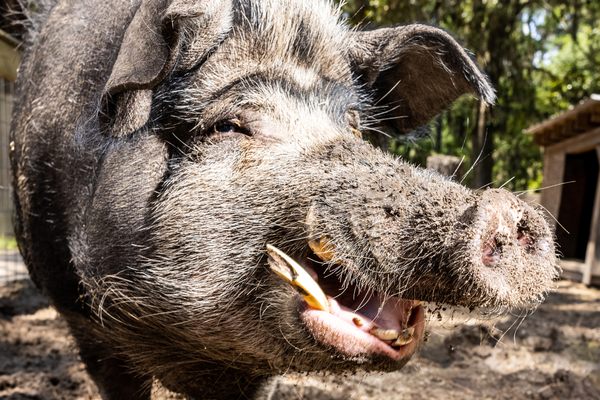














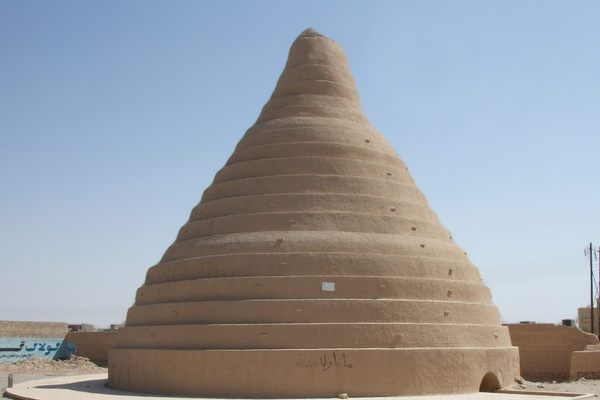






Follow us on Twitter to get the latest on the world's hidden wonders.
Like us on Facebook to get the latest on the world's hidden wonders.
Follow us on Twitter Like us on Facebook